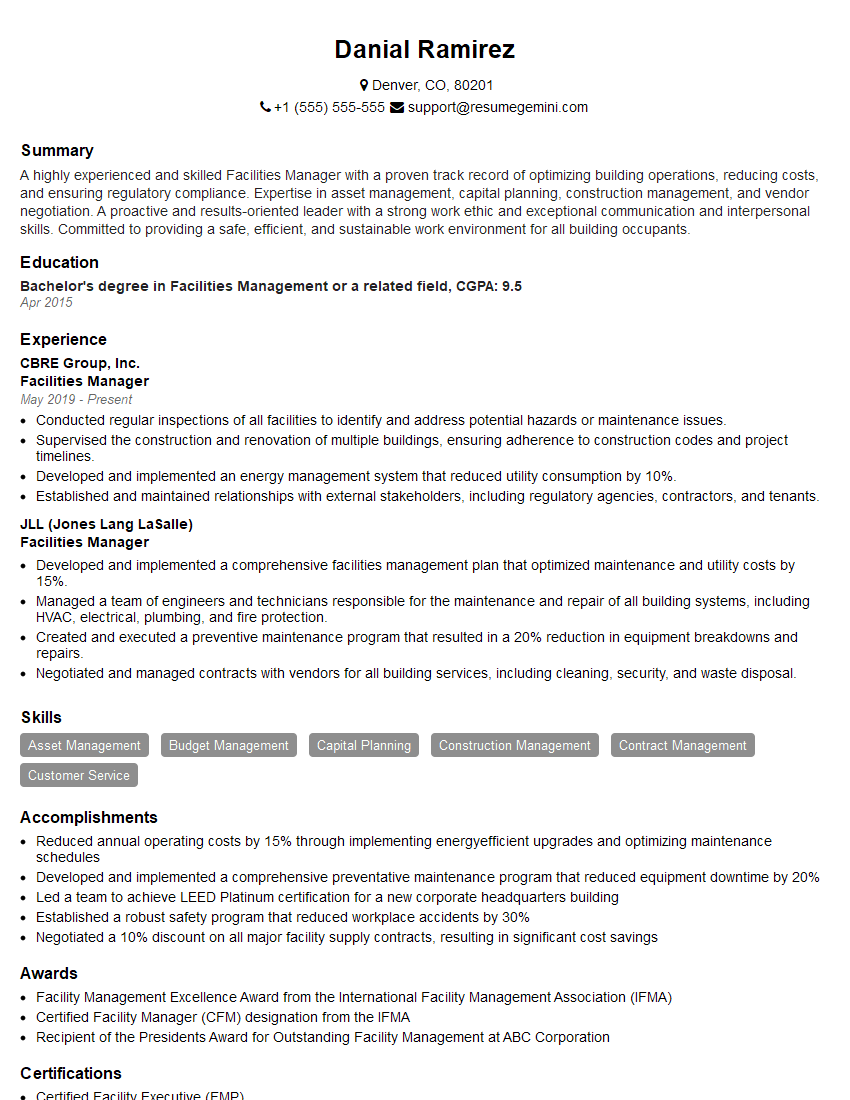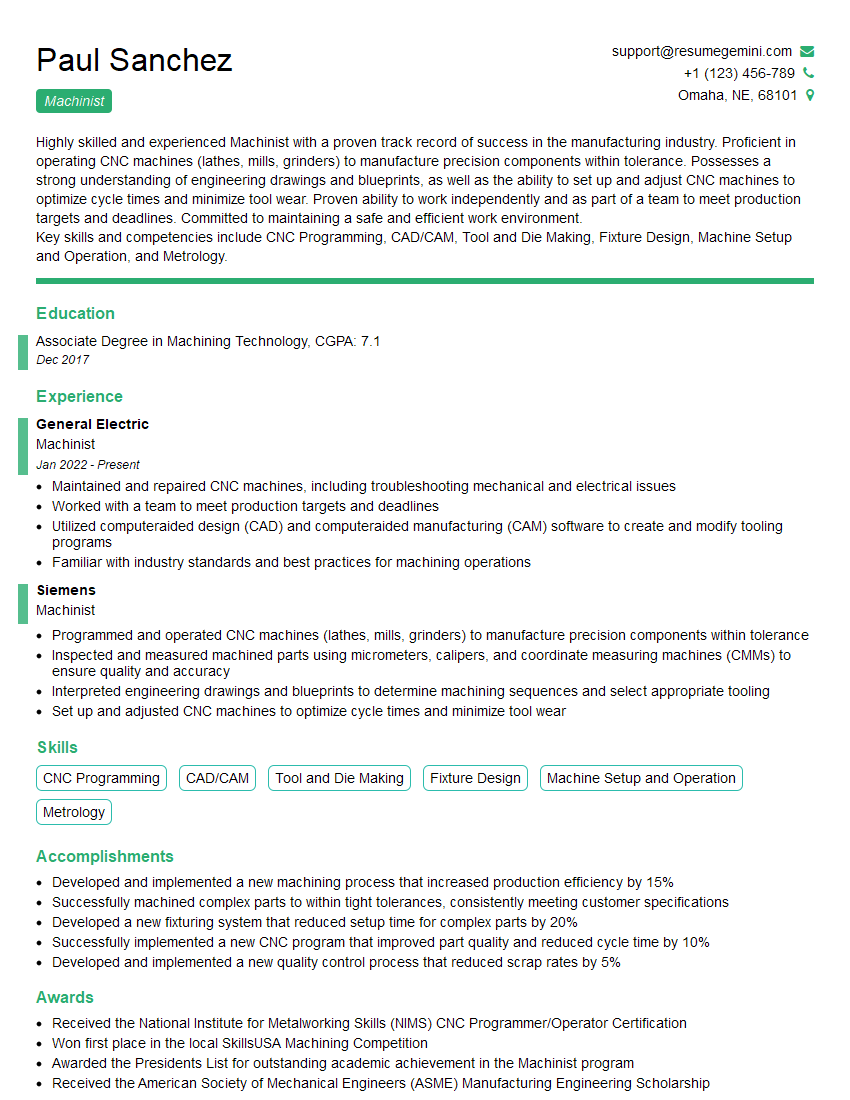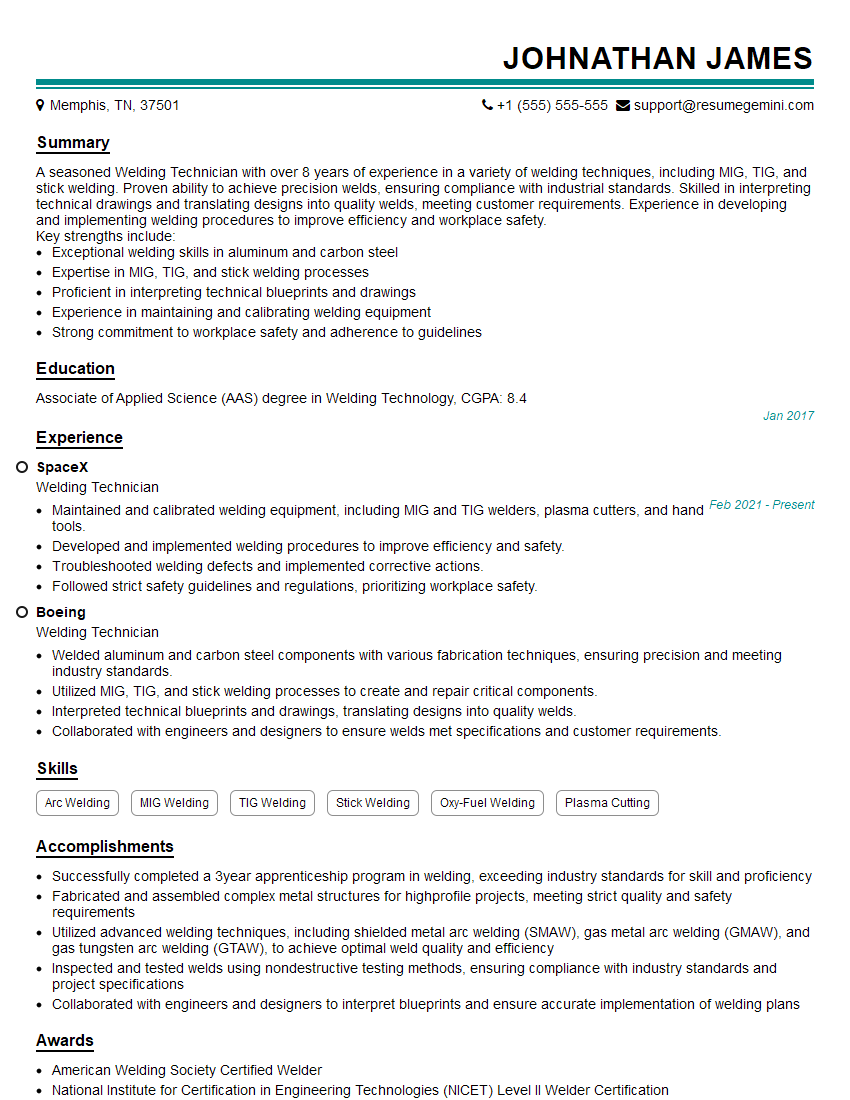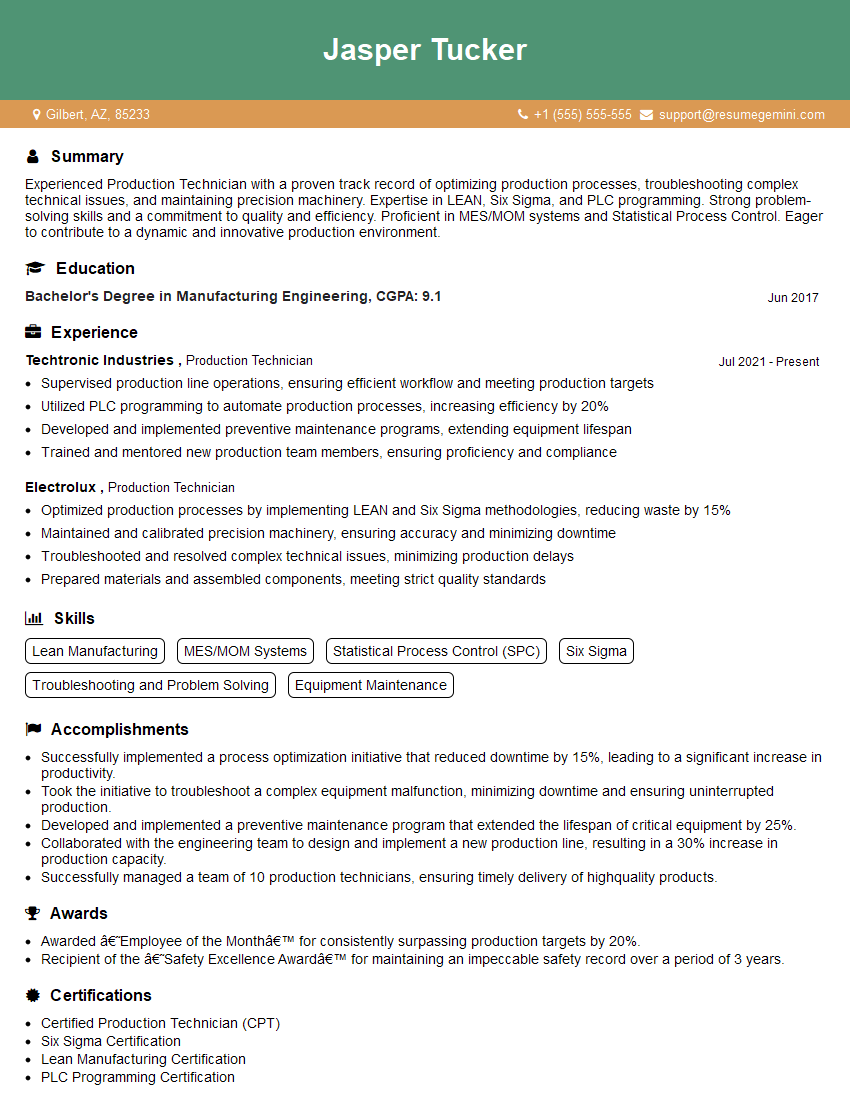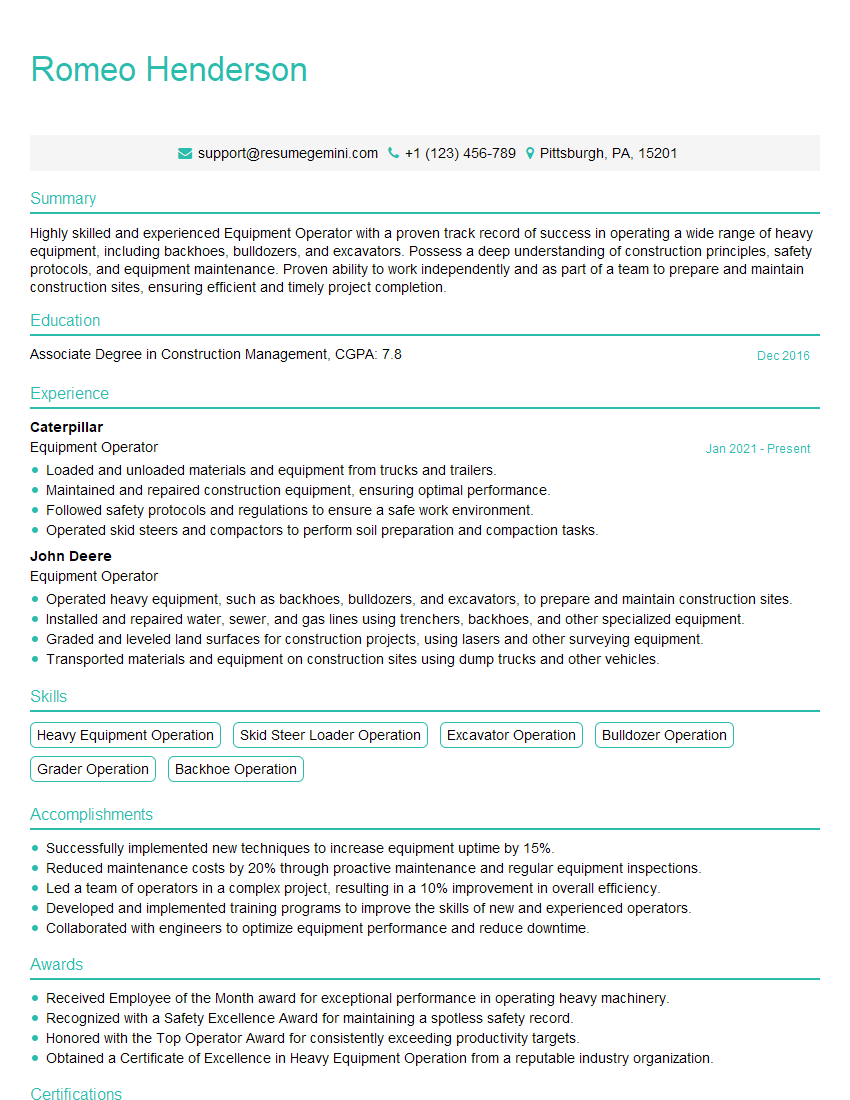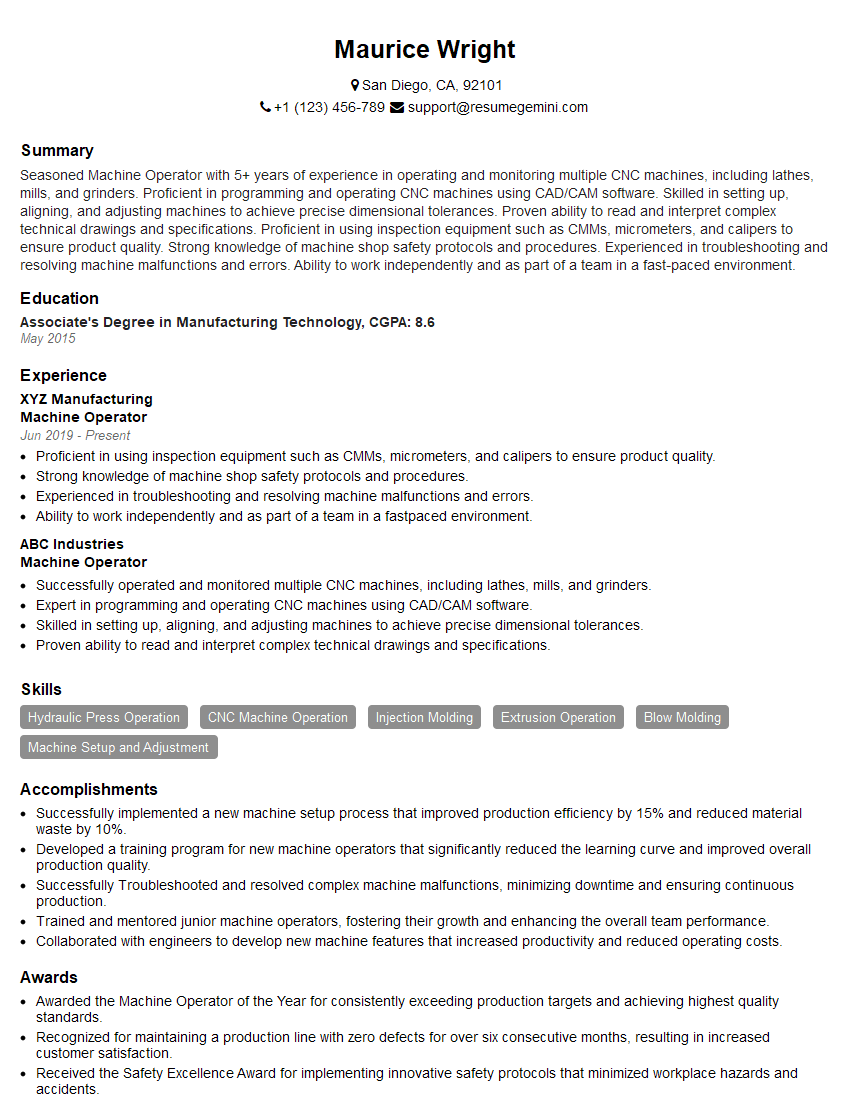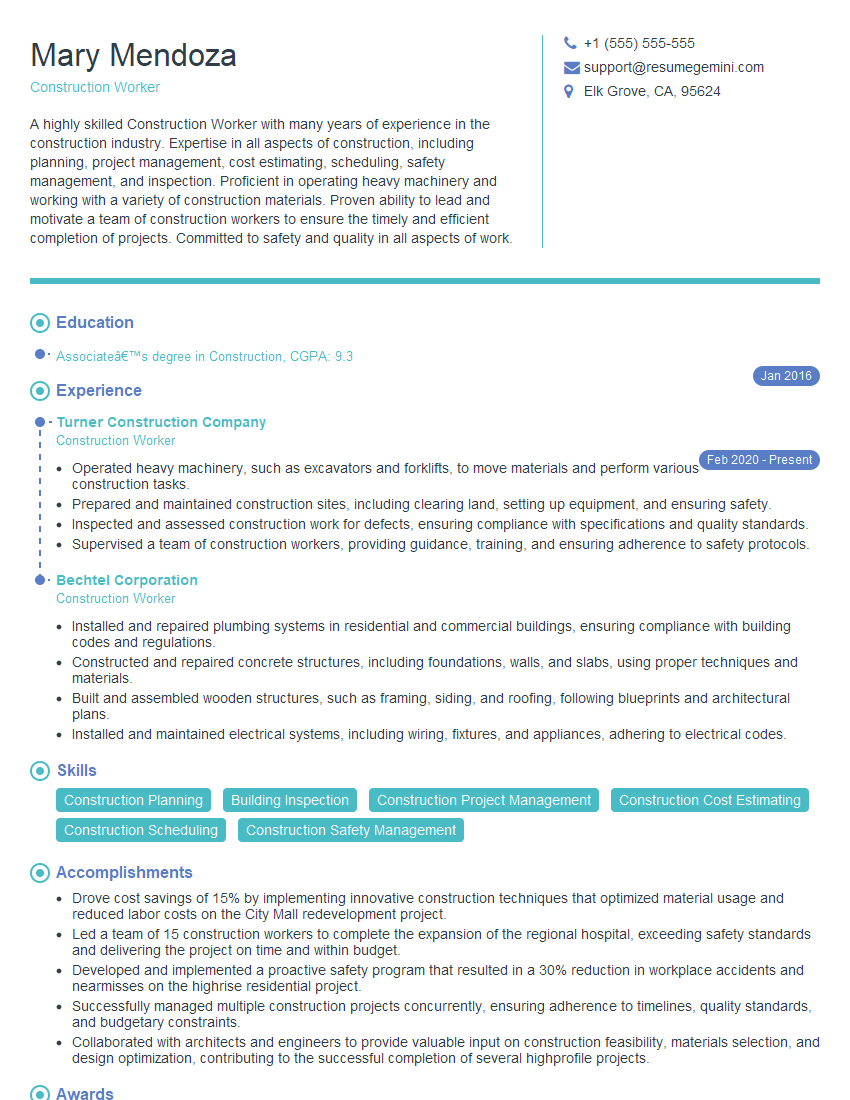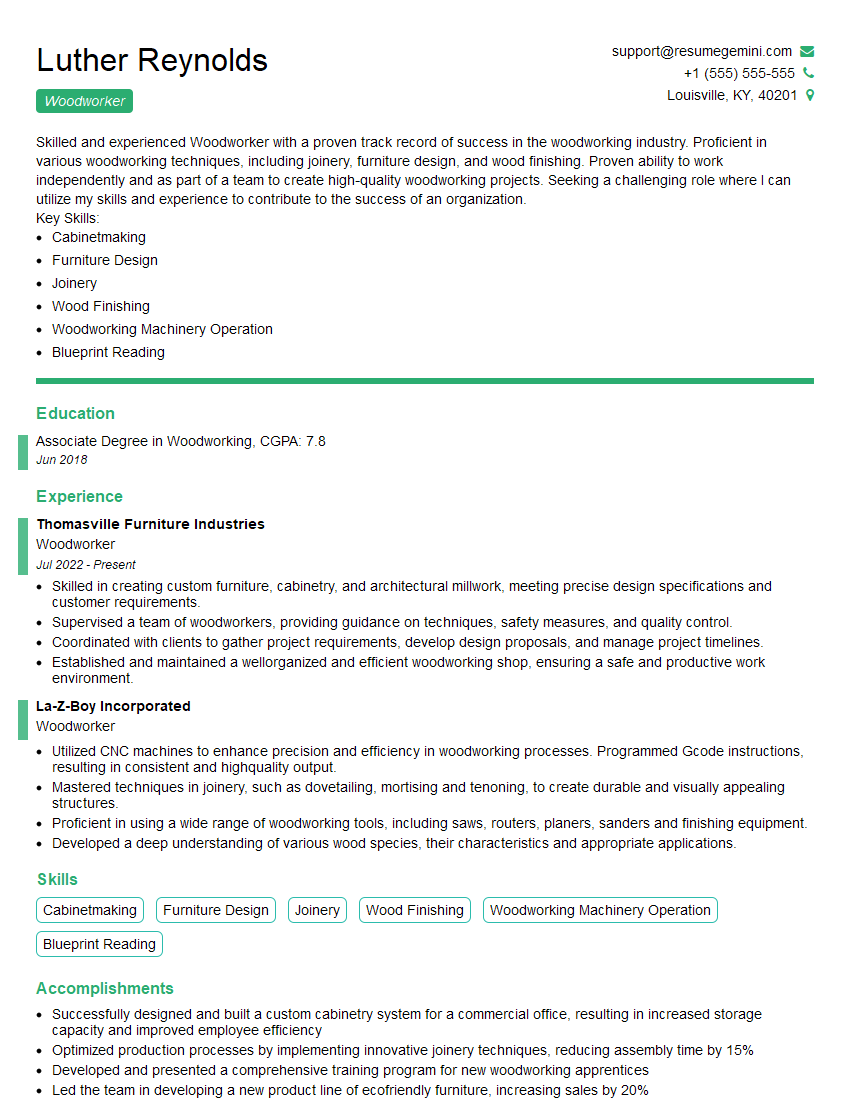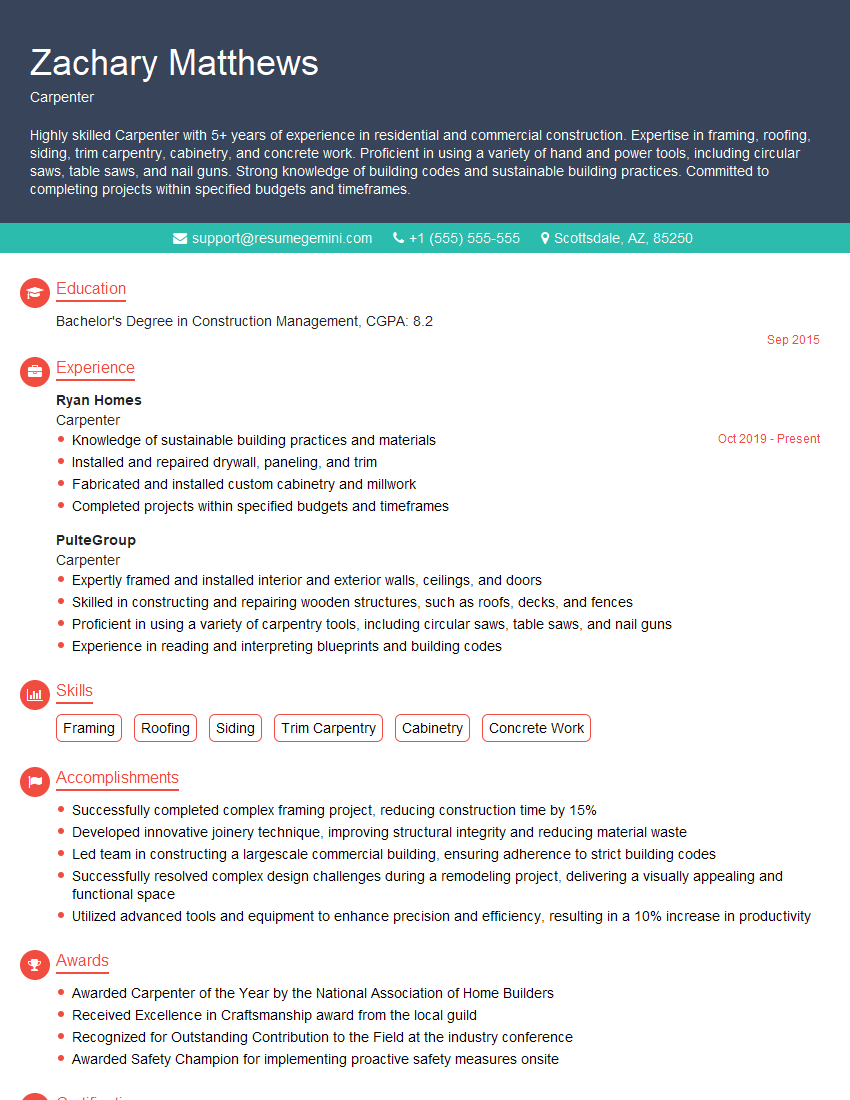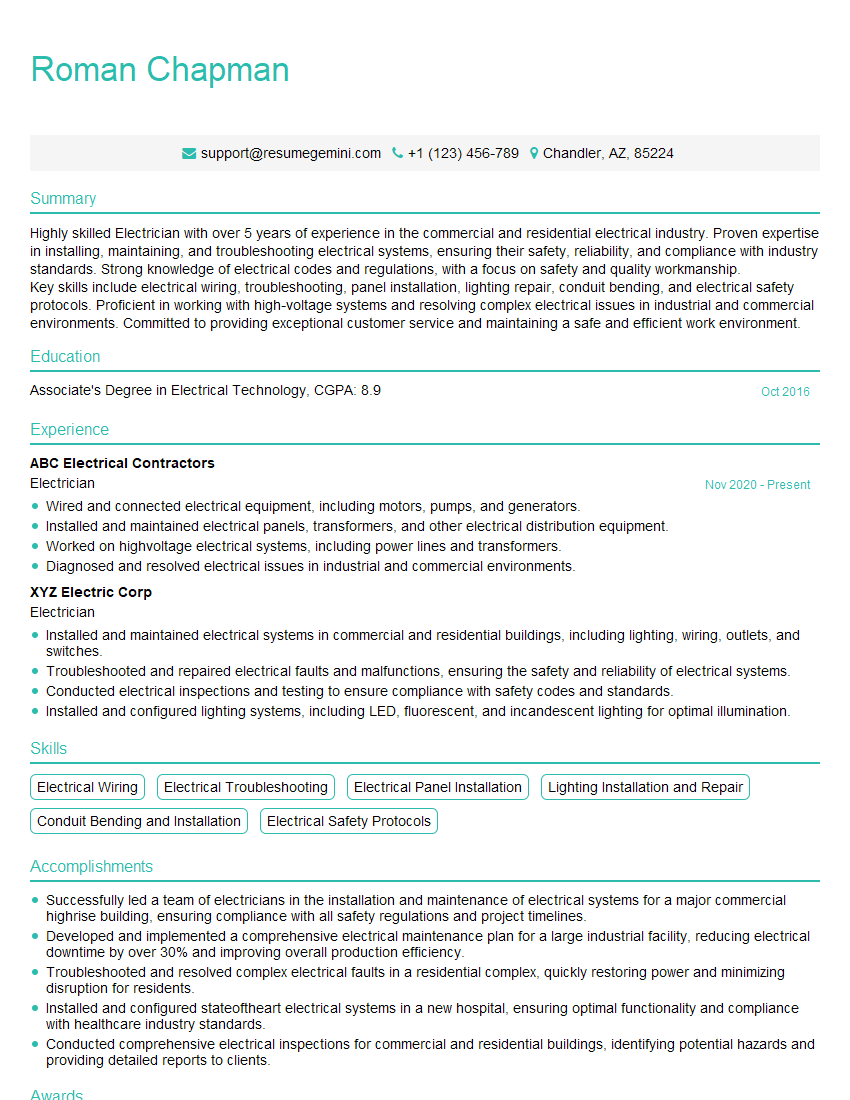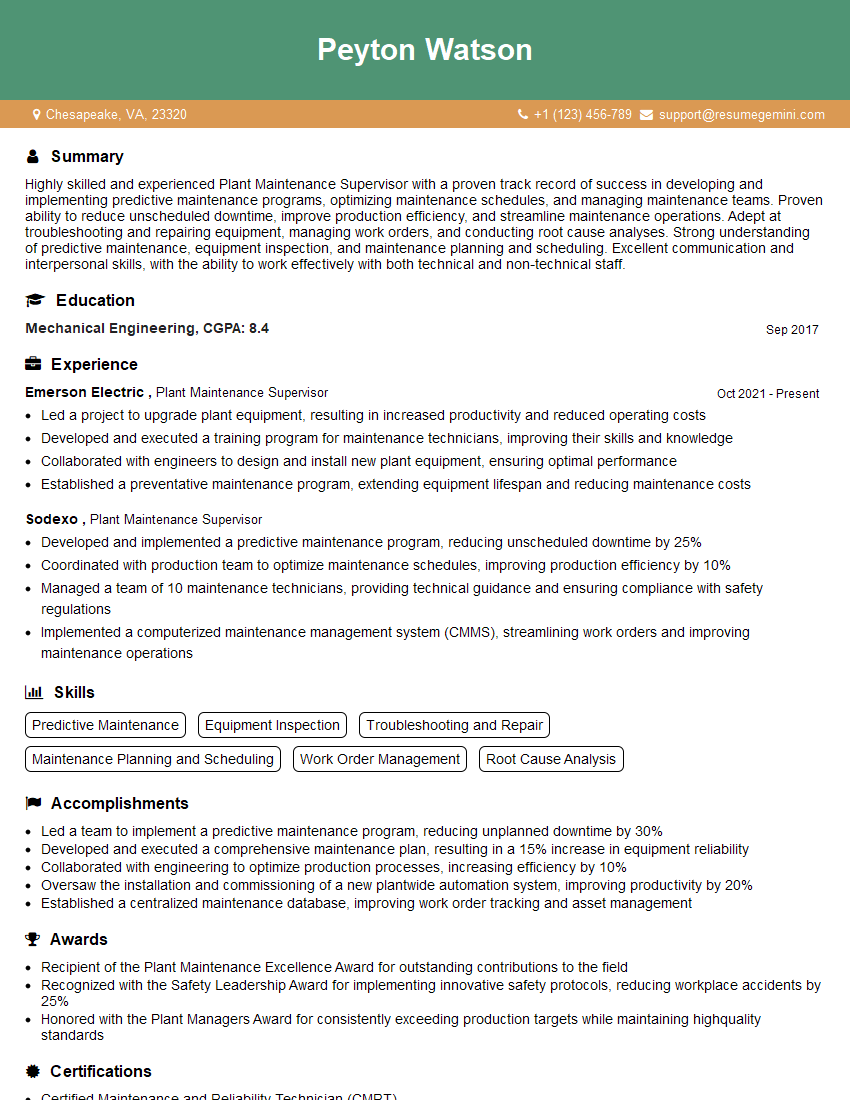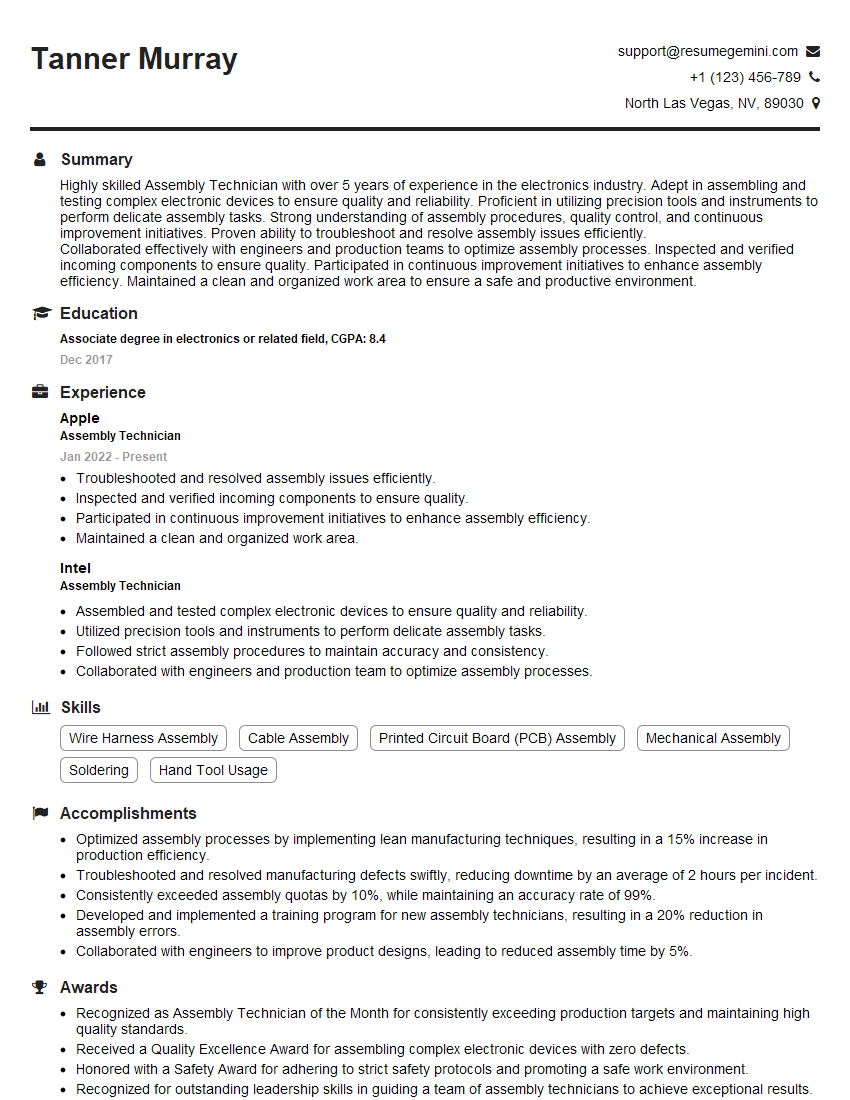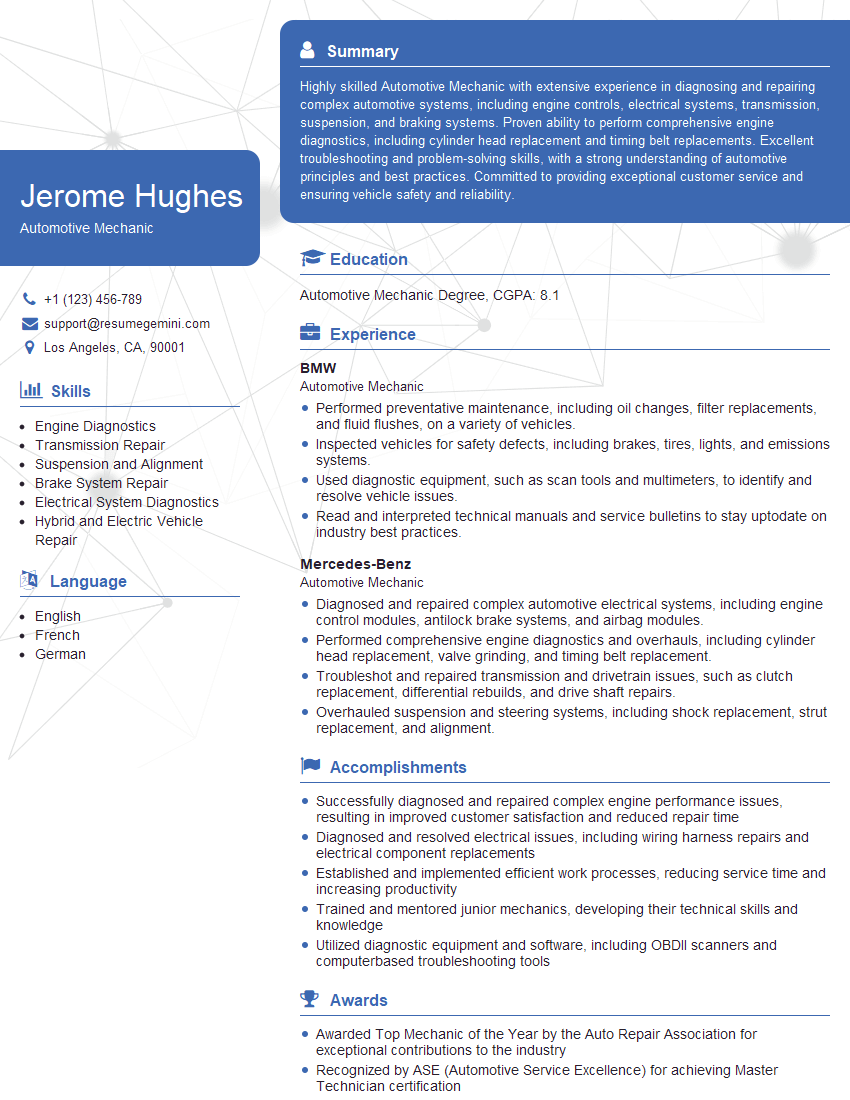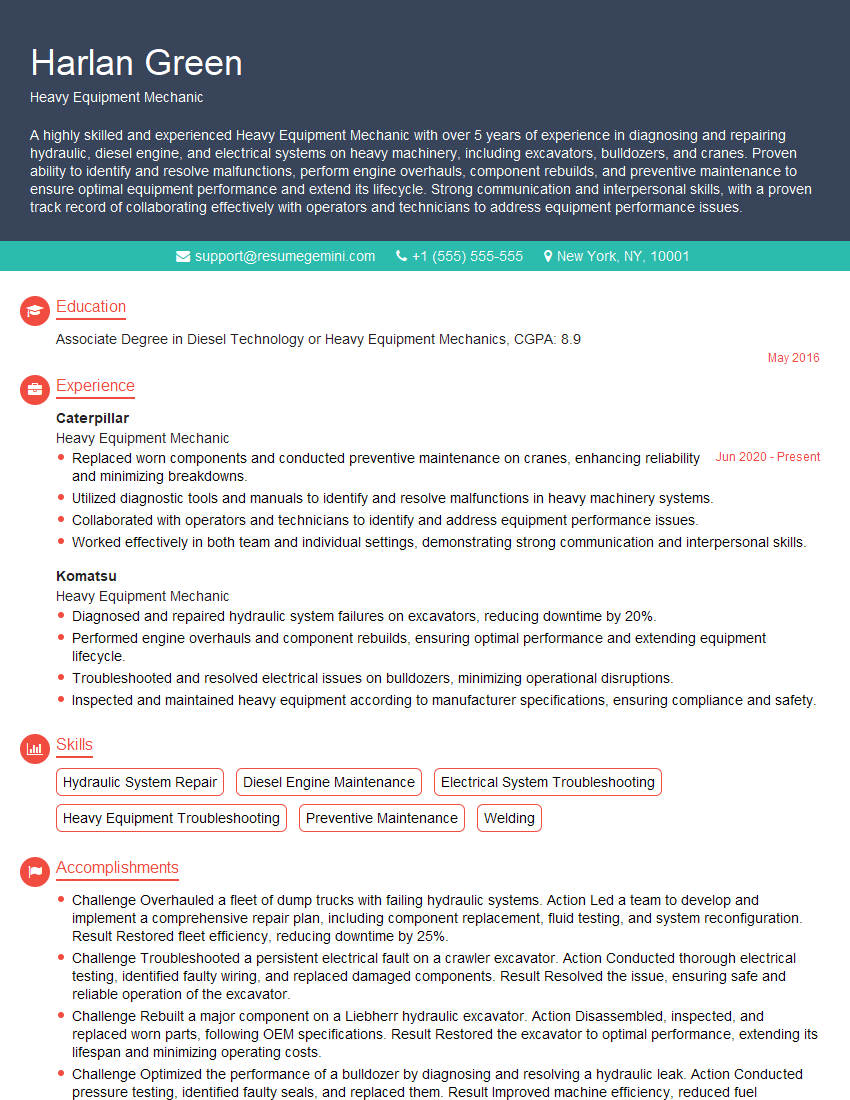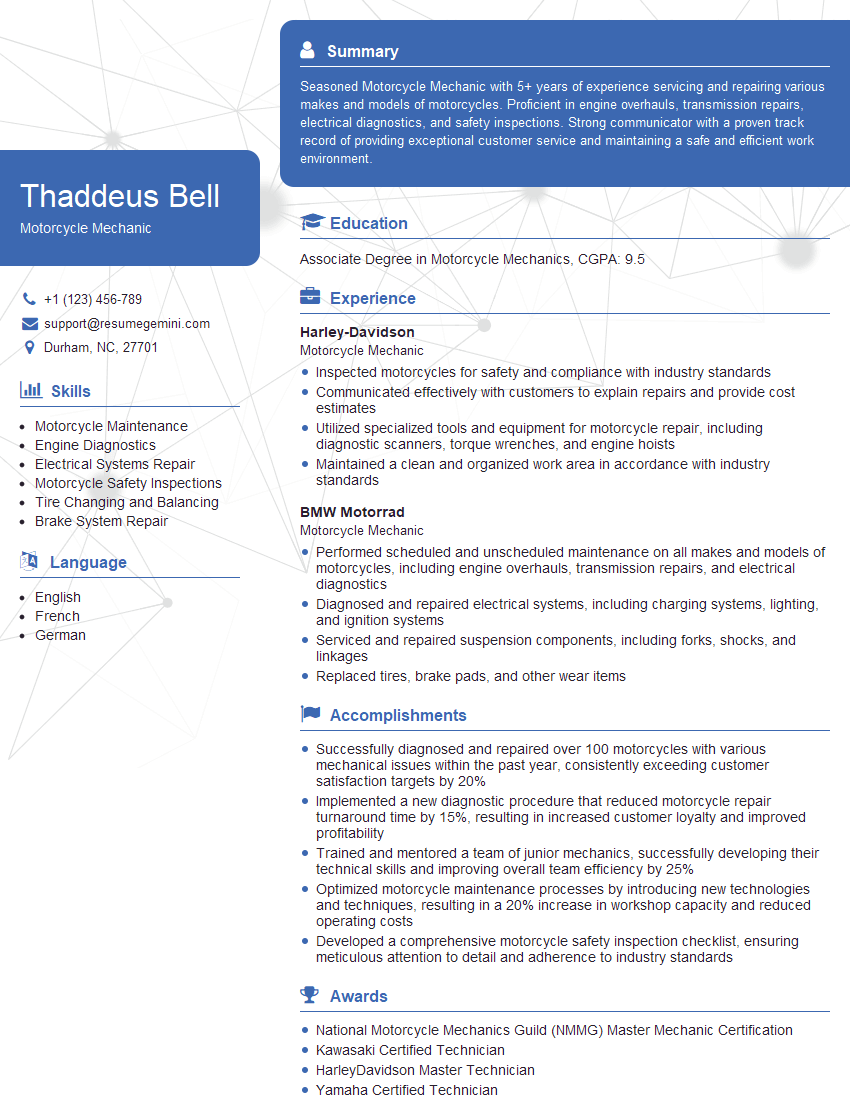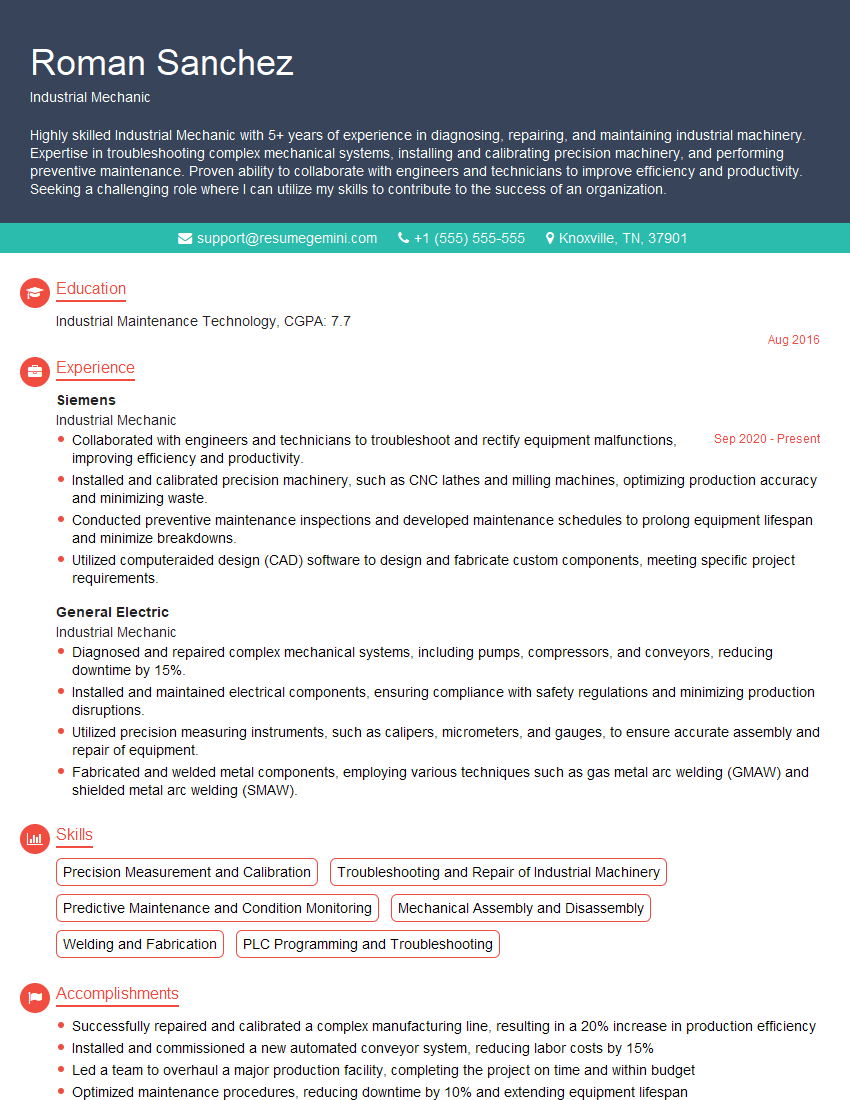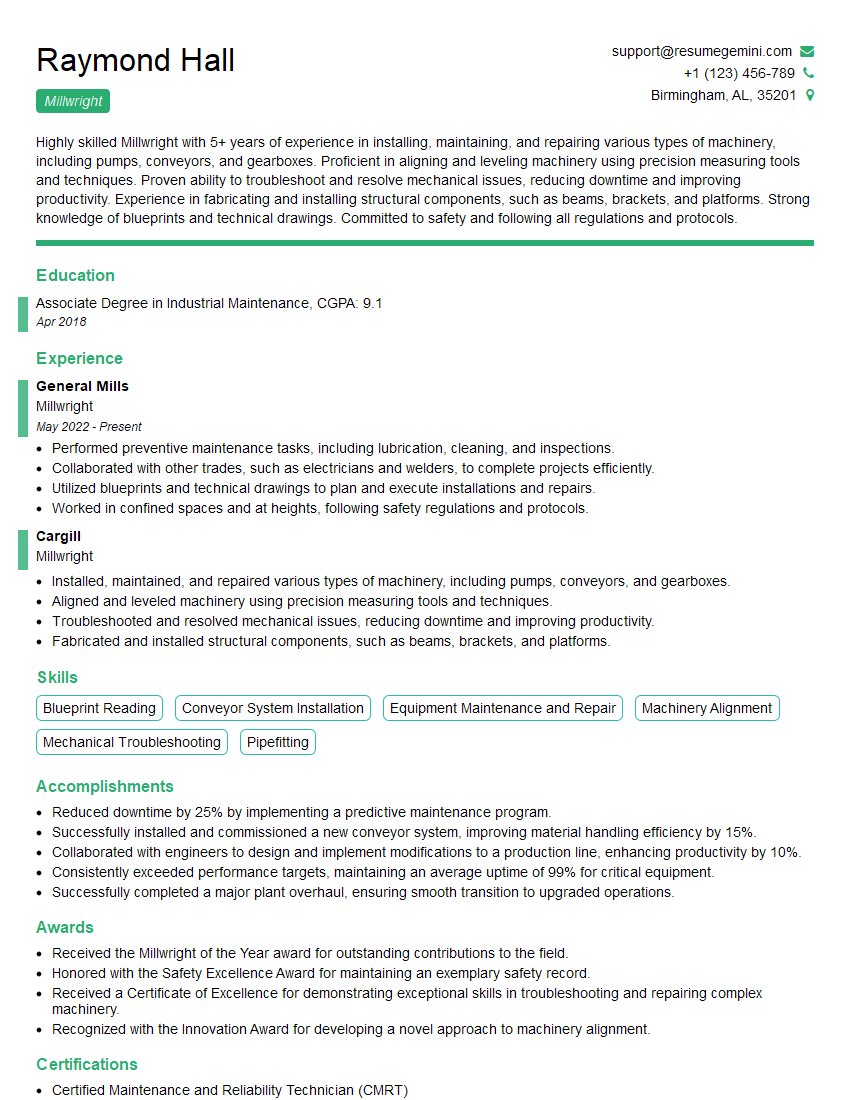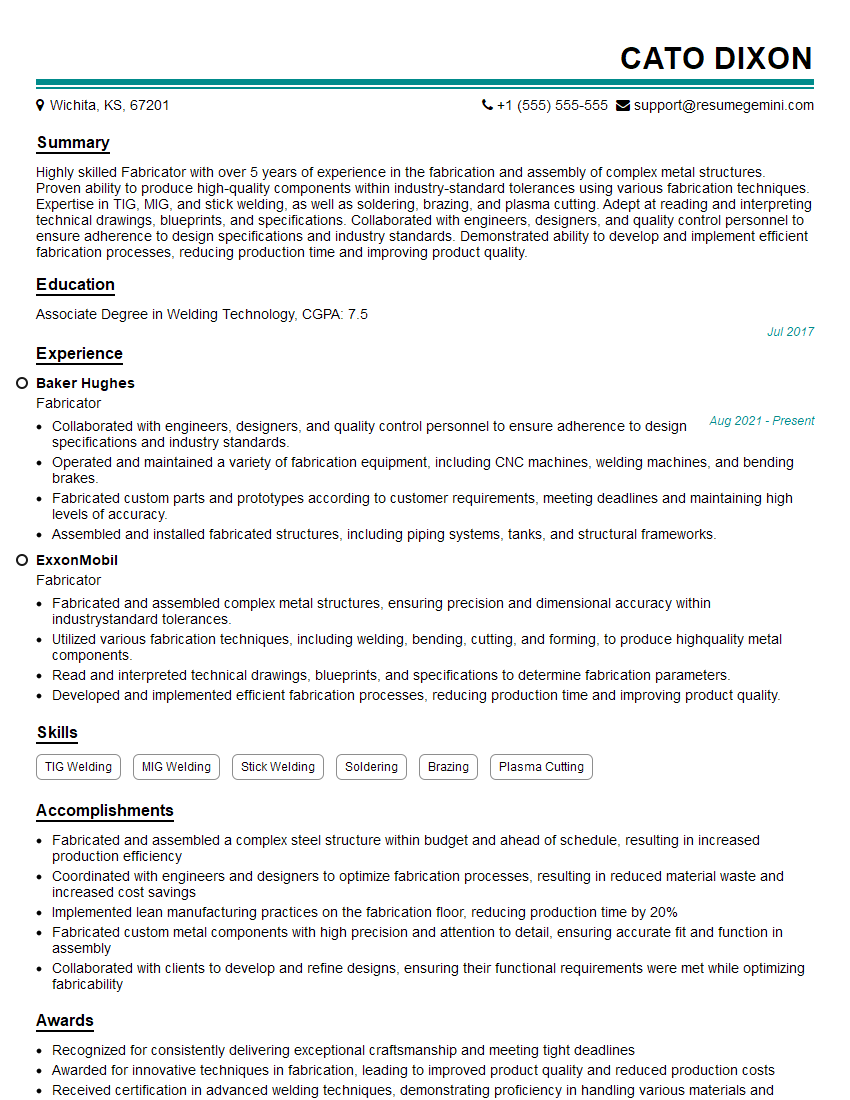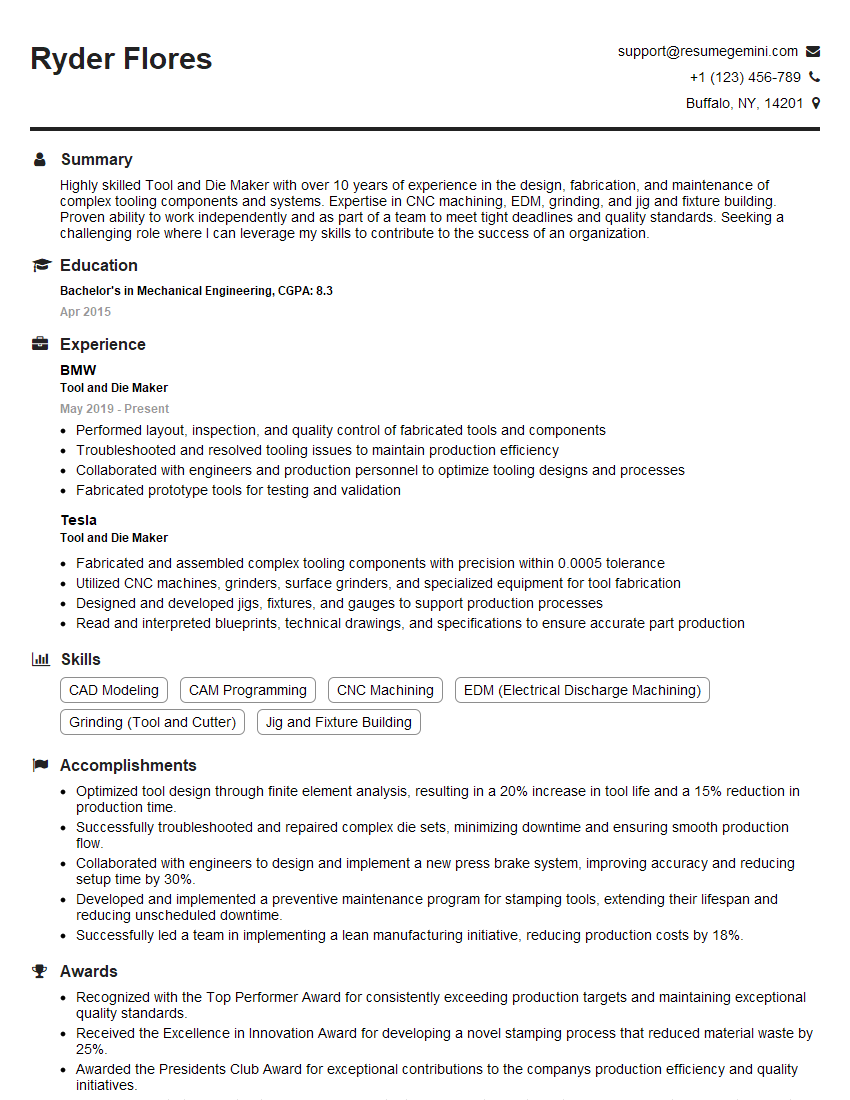The right preparation can turn an interview into an opportunity to showcase your expertise. This guide to Proficient in using power tools and machinery interview questions is your ultimate resource, providing key insights and tips to help you ace your responses and stand out as a top candidate.
Questions Asked in Proficient in using power tools and machinery Interview
Q 1. Describe your experience with different types of saws (circular, miter, table).
My experience with saws spans various types, each suited for different tasks. Circular saws are my workhorse for straight cuts in wood and other materials. I’m proficient in adjusting the blade depth and bevel for precise cuts, understanding the importance of blade selection based on the material being cut. For example, a fine-tooth blade for hardwoods ensures a cleaner cut than a coarser blade. Miter saws are indispensable for accurate angled cuts, crucial in framing and trim work. I’m familiar with using the various stops and adjustments to achieve repeatable, precise cuts, essential for things like crown molding installation. Finally, table saws offer superior control and safety for repetitive cuts and ripping lumber. I’m experienced with using push sticks and featherboards to maintain safe cutting practices, always prioritizing safety and accuracy. I’ve used all three extensively on projects ranging from simple furniture building to complex architectural models.
Q 2. Explain the safety procedures for operating a drill press.
Safety is paramount when operating a drill press. Before starting, I always ensure the work piece is securely clamped to the table to prevent movement. Loose clothing and jewelry are removed to avoid entanglement. I use appropriate safety glasses or a face shield to protect my eyes from flying debris. The speed is selected based on the material and drill bit size; forcing a bit through material at the wrong speed can lead to breakage and injury. I always maintain a firm grip on the handle and feed the bit steadily, never forcing it. After completion, I always make sure the machine is switched off and the bit is securely removed, keeping hands clear of moving parts. A common mistake is not adequately securing the workpiece, which can lead to kickback or injury.
Q 3. How do you maintain and troubleshoot a pneumatic impact wrench?
Maintaining a pneumatic impact wrench involves regular cleaning and lubrication. I check the air hose for any damage or leaks and ensure the connections are secure. After use, I remove any debris from the anvil and socket. Lubrication is key – I use the recommended lubricant to keep the moving parts functioning smoothly. Troubleshooting typically involves checking the air supply pressure; low pressure will affect the wrench’s performance. If it’s not functioning correctly, I inspect the exhaust port for blockages. Sometimes, a simple tap can dislodge any debris. If the problem persists, I will consult the manufacturer’s manual and perform a more in-depth inspection or consider professional servicing. In a recent project, a sudden drop in impact power was traced to a blockage in the exhaust. A quick cleaning resolved the issue, saving time and preventing further damage.
Q 4. What are the different types of welding equipment and their applications?
Welding encompasses various types of equipment each with specific applications. Shielded Metal Arc Welding (SMAW), commonly known as stick welding, uses a consumable electrode to create the weld. It’s versatile and suitable for various metals in different environments, particularly outdoors. Gas Metal Arc Welding (GMAW), or MIG welding, uses a continuous wire electrode fed automatically, resulting in faster welding speeds. It is ideal for thinner materials and producing cleaner welds. Gas Tungsten Arc Welding (GTAW), or TIG welding, uses a non-consumable tungsten electrode and offers superior control and weld quality, often preferred for precision work on aluminum and stainless steel. Arc welding, in general, requires a welding machine, electrodes, filler materials, and safety equipment like PPE. The choice of welding method depends on factors like material, thickness, desired weld quality, and the available equipment.
Q 5. Describe your experience with CNC machining.
My CNC machining experience includes operating and programming various machines, including mills and lathes. I’m proficient in using CAD/CAM software to design and generate CNC programs, translating complex 3D models into machine-readable code. This involves selecting the appropriate cutting tools, feed rates, and depth of cuts based on the material and desired finish. I’m experienced in setting up and operating the machines, ensuring the safe and efficient machining of parts. For example, recently, I used a CNC mill to machine a complex aluminum part requiring multiple operations, including drilling, milling, and tapping. Careful planning and programming were crucial for achieving the desired tolerances and surface finish. I regularly inspect parts for dimensional accuracy and surface quality. Effective CNC programming and operation minimizes errors and material waste.
Q 6. How do you ensure the safe operation of a forklift?
Safe forklift operation is paramount. Before starting, I always perform a pre-operational inspection, checking fluid levels, tire pressure, and overall mechanical condition. I ensure the load is properly secured using appropriate straps and chains, and that the weight is within the forklift’s capacity. I always operate the forklift at a safe speed and avoid sharp turns, particularly when carrying a load. I maintain a clear line of sight and am constantly aware of my surroundings, pedestrian traffic, and potential obstacles. I’m trained to properly handle inclines and declines, understanding the limitations and risks involved. Before entering any traffic area I signal my intentions to other drivers. Safety is paramount, and following these steps prevents accidents and protects the surroundings and the driver.
Q 7. Explain the process of using a lathe.
Using a lathe involves several steps. First, the workpiece is mounted securely in the chuck or between centers. The cutting tool is then positioned, and the machine speed is selected based on the material and diameter of the workpiece. The process involves feeding the tool along the workpiece’s axis to create the desired shape. Different types of cuts can be used to shape the material, such as facing, turning, and boring. I’m proficient in using various cutting tools, understanding the importance of tool geometry and sharpness for achieving the desired surface finish and accuracy. Throughout the process, maintaining a firm grip on the handwheels and keeping my hands away from the rotating parts are essential. Regular tool sharpening and machine maintenance are critical for precision and safety. For example, I recently used a lathe to produce a set of custom bushings, requiring precise diameter control and surface finish.
Q 8. What are the safety precautions for working with grinding wheels?
Safety is paramount when working with grinding wheels. These high-speed tools can be dangerous if not handled correctly. Before even turning the grinder on, a thorough inspection is crucial. This includes checking for cracks or damage in the wheel itself and ensuring the guard is securely in place and properly adjusted. The wheel should be properly mounted and tightened according to the manufacturer’s instructions; a loose wheel is a recipe for disaster.
While operating the grinder, always wear appropriate personal protective equipment (PPE), including safety glasses with side shields, a face shield for added protection, hearing protection, and work gloves to prevent cuts and burns. Maintain a firm grip on the grinder and ensure that the workpiece is securely clamped or held in place to avoid kickback, which can throw the wheel off course with potentially devastating consequences. Never operate a grinder near flammable materials, and always allow the wheel to reach full operating speed before making contact with the workpiece. Finally, after use, ensure the grinder is switched off and allowed to come to a complete stop before being stored.
For example, when I was working on a large steel fabrication project, I meticulously checked a grinding wheel before commencing. I identified a small hairline fracture, immediately discarded the wheel, and replaced it with a new one. This prevented a potential serious accident.
Q 9. Describe your experience with metal fabrication techniques.
My experience in metal fabrication is extensive, encompassing various techniques like shearing, punching, bending, welding (MIG, TIG, stick), and machining. I’ve worked with a variety of metals, including steel, aluminum, and stainless steel, on projects ranging from small intricate parts to large structural components. I’m proficient in using both manual and CNC (Computer Numerical Control) machinery. For instance, I’ve used a CNC plasma cutter to create complex shapes in sheet metal with high precision for a signage project, demonstrating the ability to interpret technical drawings and operate sophisticated equipment accurately and efficiently.
Working with a team on a custom railing project required expertise in various techniques. I used a shearing machine to cut the metal to size, a press brake for bending the components into the required shape, a welding machine to join the pieces together, and finally a grinder to smooth out the welds and finish the project to the highest standards.
Q 10. How do you select the appropriate drill bit for a specific material?
Selecting the right drill bit is vital for achieving clean, accurate holes and preventing damage to both the bit and the material. The choice depends primarily on the material’s hardness and composition. For softer materials like wood, high-speed steel (HSS) bits are suitable, potentially even with a brad-point design for cleaner entry. For harder materials like steel, you’ll need a drill bit made of a harder material, such as cobalt HSS or carbide-tipped bits, which provide increased durability and cutting ability. The bit’s size should, of course, match the desired hole diameter. Additionally, consider the drill bit’s point angle; a wider angle is typically better for softer materials, while a narrower angle is suited to harder materials.
For example, when drilling through a piece of hardwood, I’d use a 1/2-inch brad-point bit. If I need to drill through a piece of stainless steel, I’d opt for a 1/4-inch cobalt HSS bit to ensure sufficient strength and prevent the bit from breaking.
Q 11. What are the different types of hand tools and their uses?
A comprehensive toolkit includes a variety of hand tools, each serving a specific purpose. These can be broadly categorized. Measuring tools like rulers, calipers, and tape measures are essential for accurate work. Striking tools, such as hammers, mallets, and chisels, are used for shaping and assembling materials. Fastening tools comprise screwdrivers (Phillips and flathead), wrenches (open-end, box-end, adjustable), and pliers (needle-nose, slip-joint). Cutting tools include hacksaws, utility knives, and wire cutters.
Beyond these, you’ll find specialized tools depending on the job. For example, when assembling furniture, a combination square is useful for checking angles and measuring, and an Allen key set is necessary for tightening screws.
Q 12. Explain the importance of proper tool maintenance.
Proper tool maintenance is not just about extending the life of your equipment; it’s a critical safety measure. A dull or damaged tool is more likely to slip, causing injury or creating a less-than-perfect result. Regular cleaning and lubrication are crucial for preventing rust and corrosion. Sharpening cutting tools like chisels and blades maintains their effectiveness and safety. Inspecting tools for cracks, damage, or wear before each use prevents accidents. Following manufacturer’s instructions for storage and maintenance is vital for preserving their functionality and extending their lifespan. Think of it like caring for a car – regular maintenance prevents more significant and costly repairs down the line.
I had a situation where a worn-out screwdriver slipped while I was tightening a screw, which resulted in a minor injury to my hand. This reinforced the importance of regular inspection and replacement of worn tools.
Q 13. How do you identify and address potential hazards when using power tools?
Identifying and addressing potential hazards when using power tools is a continuous process. It starts with a thorough risk assessment of the task, considering the specific tool, materials, and environment. This includes recognizing potential hazards such as entanglement in moving parts, electrical shock, kickback, and flying debris. The next step is to implement the appropriate control measures, including using appropriate PPE, ensuring adequate ventilation, establishing a safe working area, and following the manufacturer’s instructions and safety guidelines. Regular inspections of the tools and equipment are also important. It’s a proactive approach, anticipating problems before they occur.
For instance, when using a circular saw, I always make sure the blade guard is correctly fitted and the material is firmly secured to the work surface to prevent kickback. In addition, I ensure adequate lighting and a clear workspace to minimize the risks associated with the operation.
Q 14. Describe your experience with preventative maintenance on machinery.
Preventative maintenance is a cornerstone of efficient and safe machinery operation. My experience involves regular lubrication of moving parts, checking for wear and tear on critical components, and cleaning and inspecting machinery after each use. I maintain detailed records of all maintenance activities, including the date, type of service, and any issues identified. This documentation is crucial for tracking the machine’s condition and predicting potential problems. Following a scheduled preventative maintenance routine helps to detect minor issues before they escalate into major breakdowns, minimizing downtime and ensuring the equipment’s longevity and safety.
I once prevented a major equipment failure by regularly checking the oil levels and belts in a large lathe. Early detection of a failing belt allowed for a timely replacement, preventing a costly and time-consuming repair.
Q 15. What are the signs of a malfunctioning machine?
Identifying a malfunctioning machine often involves a combination of observation and listening. Look for unusual noises – grinding, squealing, knocking, or unusual vibrations – these can indicate worn bearings, loose parts, or internal damage. Unusual smells like burning rubber or electrical components are also serious red flags. Visually inspect the machine for leaks (oil, coolant, hydraulic fluid), damage to belts or chains, loose connections, or any signs of overheating (discoloration, warping). Finally, monitor the machine’s performance; inconsistent output, reduced power, or failure to operate correctly are clear indicators of a problem.
For example, a wood lathe that begins vibrating excessively might have a loose chuck or worn bearings. A circular saw that stalls under a normal load might have a dull blade or a clogged motor vent. These observable signs help pinpoint the exact area to focus on for troubleshooting.
Career Expert Tips:
- Ace those interviews! Prepare effectively by reviewing the Top 50 Most Common Interview Questions on ResumeGemini.
- Navigate your job search with confidence! Explore a wide range of Career Tips on ResumeGemini. Learn about common challenges and recommendations to overcome them.
- Craft the perfect resume! Master the Art of Resume Writing with ResumeGemini’s guide. Showcase your unique qualifications and achievements effectively.
- Don’t miss out on holiday savings! Build your dream resume with ResumeGemini’s ATS optimized templates.
Q 16. How do you troubleshoot a malfunctioning power tool?
Troubleshooting a malfunctioning power tool follows a structured approach. First, Safety First! Always disconnect the power tool from its source before attempting any repairs. Next, carefully examine the tool for any obvious problems: loose connections, damaged cords, broken parts, or foreign objects obstructing the mechanism. If the problem is apparent (e.g., a broken switch), repair or replace the faulty component. If the issue is more complex, a methodical approach is necessary. Start with the simplest checks – is the power supply working correctly? Is the tool properly connected? Check the blades or bits for damage or wear. If the problem persists, consult the owner’s manual for troubleshooting steps specific to the model. In some cases, you might need to take the tool apart for further diagnostics (only if you are skilled and familiar with its internals). Remember, if you’re unsure, consult a qualified repair technician. Never attempt repairs beyond your skill level.
For instance, if a drill suddenly stops working, I’d first check the power cord and outlet, then the battery (if cordless), and finally inspect the chuck and bit for any obstructions.
Q 17. Describe your experience with hydraulic systems.
My experience with hydraulic systems encompasses both maintenance and operation. I’ve worked extensively with hydraulic presses, lifts, and excavators. I understand the importance of maintaining correct fluid levels, checking for leaks, and identifying potential pressure issues. I’m familiar with various hydraulic components, including pumps, valves, cylinders, and accumulators. I can identify common malfunctions such as leaks, low pressure, and component failures, and perform basic maintenance tasks like checking fluid levels, replacing filters, and tightening connections. I understand the safety precautions involved in handling hydraulic fluids and high-pressure systems, always prioritizing safe operating procedures.
On one project involving a large hydraulic press, I identified a slow leak in a high-pressure line by systematically checking all connections. This prevented a potential equipment failure and ensured the safety of the operating personnel. Addressing that leak early saved time and significant repair costs later.
Q 18. What are your preferred methods for measuring and marking materials?
Accurate measurement and marking are crucial for precision work. My preferred methods depend on the material and the level of accuracy required. For precise measurements, I use digital calipers and measuring tapes, ensuring proper alignment and zeroing before each use. For marking, I use a combination of marking pencils, scribes, and even fine-tip markers, depending on the material and visibility requirements. I also utilize squares, levels, and speed squares to ensure straight lines and precise angles. For larger projects, I may use chalk lines or laser levels for consistent and accurate marking across longer distances.
For instance, when cutting intricate joinery, I rely on my digital calipers to ensure precise measurements, and a marking knife to make clean, visible lines on the wood before cutting. For laying out the foundation of a structure, I use a laser level to ensure perfect leveling across a large area.
Q 19. How do you ensure the accuracy of your work when using power tools?
Ensuring accuracy when using power tools involves a multi-faceted approach. Firstly, it’s essential to use the right tool for the job. Secondly, I always ensure the tools are properly maintained and calibrated (if applicable), with sharp blades and bits. Before starting any operation, I double-check my measurements and markings, ensuring they are accurate and clearly visible. I use jigs and guides wherever possible to ensure consistent cuts and avoid errors. I work slowly and deliberately, focusing on precision and control, rather than speed. Finally, I regularly inspect the workpiece during the process to identify and correct any deviations early on, minimizing waste and rework.
For example, when cutting a complex curve on a router, using a template and a router guide ensures the accuracy of the cut and prevents accidental damage.
Q 20. Explain your experience with different types of fasteners (bolts, screws, rivets).
My experience with fasteners is extensive. I’m proficient in using various types of bolts (carriage, machine, hex), screws (wood, metal, self-tapping), and rivets (solid, blind). I understand the different applications and strengths of each fastener type. I select fasteners based on the material being joined, the required strength, and the desired aesthetic result. I’m familiar with various drive types (Phillips, slotted, Torx) and appropriate tools for installation, including impact drivers, drills, and rivet guns. I understand the importance of using the correct torque for bolts to ensure proper tightening without stripping the threads. Improper fastening can lead to structural failure or damage to materials; proper selection and installation are essential for reliable performance.
I once had to repair a critical structural component where a previous installer had used the wrong type of bolt. The correct selection of high-strength bolts, properly torqued, prevented a potentially serious safety hazard.
Q 21. Describe your experience with blueprint reading.
Blueprint reading is a fundamental skill for any professional in my field. I’m comfortable interpreting various types of blueprints, including architectural, mechanical, and electrical drawings. I understand symbols, notations, and dimensions, and can accurately translate those two-dimensional representations into three-dimensional constructions. I can identify different views (plan, elevation, section), understand scaling, and interpret material specifications. I can use the blueprints to identify materials, dimensions, and assembly procedures. My experience extends to both manual and digital blueprint reading, including the use of CAD software to visualize and manipulate designs.
A recent project involved constructing a complex piece of custom machinery. Accurate reading of the blueprint, including detailed dimensions and assembly instructions, was crucial for building a functioning and safe machine. Understanding the blueprint ensured the proper alignment of all components and the successful completion of the project.
Q 22. How do you handle emergency situations involving power tools or machinery?
My approach to emergency situations involving power tools and machinery prioritizes safety and swift action. The first step is always to immediately shut down the machine – pulling the emergency stop button or disconnecting the power source. This prevents further injury or damage. Next, I assess the situation, checking for injuries to myself or others. If anyone is injured, I immediately provide first aid if I’m qualified, and call emergency services. Then, I secure the area to prevent further accidents. Finally, I document the incident, including the cause (if known), any injuries, and steps taken. For example, if a blade malfunctions on a table saw, I’d immediately hit the emergency stop, then carefully inspect the blade and its housing for damage or misalignment, preventing anyone else from attempting to use the faulty equipment. Post-incident, I would file a detailed incident report with my supervisor, to initiate any necessary repairs or safety improvements.
Q 23. What safety certifications do you hold related to power tools or machinery?
I hold several safety certifications relevant to power tool and machinery operation. These include OSHA 10-hour General Industry certification, demonstrating my understanding of workplace safety regulations. Additionally, I possess certifications specific to operating various machines, like a forklift certification and a certification for operating specific types of CNC machinery, the specifics of which would depend on the requirements of the role. These certifications show a commitment to safe and compliant practices. I regularly refresh these certifications to maintain my expertise.
Q 24. Explain your experience with different types of cutting tools.
My experience spans a wide range of cutting tools, from hand tools to sophisticated CNC machines. I’m proficient with various saws, including circular saws, miter saws, table saws, and band saws, understanding the specific applications and safety procedures for each. I also have extensive experience with routers, shaping and trimming wood and other materials precisely. For metal cutting, I’m skilled in using various abrasive cutting wheels, band saws, and plasma cutters. My experience extends to using specialized tools such as laser cutters, which demand high precision and careful control. I adapt my tool selection based on the material, desired precision, and overall project requirements. For instance, when working with delicate materials like veneers, I would choose hand tools or a precision router over a powerful circular saw to avoid damage.
Q 25. Describe your understanding of OSHA regulations related to power tool safety.
My understanding of OSHA regulations concerning power tool safety is thorough. I know the importance of regular machine inspections to identify and correct potential hazards (like damaged cords or guards). I’m aware of the regulations surrounding personal protective equipment (PPE), including the mandatory use of eye protection, hearing protection, and appropriate clothing when operating machinery. Lockout/Tagout procedures are paramount to my workflow, ensuring machinery is safely de-energized before maintenance or repair. I also understand the importance of proper training, ensuring all personnel are familiar with operating procedures and safety protocols. For instance, I know OSHA mandates regular inspections of electrical equipment to prevent electrical hazards and that failure to adhere to these regulations could result in serious injury or fines. I am committed to maintaining a safe working environment in accordance with all applicable OSHA guidelines.
Q 26. How do you ensure the quality of your work when using power tools and machinery?
Ensuring quality output when using power tools involves a multi-faceted approach. First, I meticulously plan my work, ensuring accurate measurements and precise setups. Second, I use the appropriate tool for the job, understanding its capabilities and limitations. Third, I maintain my tools in excellent condition, regularly cleaning, sharpening, and replacing parts as needed. This prevents errors from dull tools or equipment malfunctions. Fourth, I rigorously inspect my work at each stage, correcting any imperfections before moving on. For example, when milling a complex part, I’d use a dial indicator to constantly monitor accuracy and adjust parameters as needed, aiming for tolerances within specific microns. Lastly, proper material selection plays a crucial role in ensuring the quality and longevity of the final product.
Q 27. Describe a time you had to troubleshoot a complex machinery issue.
During a manufacturing run, our CNC router experienced unexpected stoppages. Initial troubleshooting pointed towards a possible software glitch. However, after reviewing the machine logs and systematically testing the software, I found no error. I then checked the mechanical components, focusing on the motion control systems. It turned out a crucial bearing within the X-axis movement was worn and causing intermittent jamming. By identifying the faulty bearing, replacing it, and then running a comprehensive series of tests, we resolved the issue. This experience highlighted the importance of systematic troubleshooting, starting with the most likely causes and progressively investigating more complex possibilities. It also reinforced the necessity of thorough documentation and regular machine maintenance to prevent future similar issues.
Q 28. Explain your experience with robotic automation in manufacturing.
My experience with robotic automation in manufacturing is primarily focused on collaborative robots (cobots). I’ve worked with cobots assisting in tasks like precision assembly, material handling, and quality control. I understand the programming logic behind these systems, including the use of industrial PLCs and programming languages like RAPID (for ABB robots) or others depending on the specific robotic arm used. This involves developing and implementing robot programs, adjusting parameters for optimal performance, and ensuring safe interaction between human workers and the robots. For instance, I’ve worked on a project where a cobot was integrated into an assembly line to perform repetitive tasks, reducing human error and increasing production efficiency. My role involved integrating the cobot’s movements with the existing machinery and ensuring worker safety through proper safety protocols and protective measures.
Key Topics to Learn for Proficient in using power tools and machinery Interview
- Safety Procedures and Regulations: Understanding and adhering to all relevant safety protocols, including proper PPE usage, machine guarding, and lockout/tagout procedures. This demonstrates responsibility and a commitment to workplace safety.
- Types of Power Tools and Machinery: Familiarity with various power tools (drills, saws, sanders, etc.) and machinery (lathes, milling machines, welders, etc.), including their applications and limitations. Be prepared to discuss specific tools you’ve used extensively.
- Maintenance and Troubleshooting: Knowledge of routine maintenance tasks, such as cleaning, lubrication, and minor repairs. Demonstrate your ability to identify and troubleshoot common issues, minimizing downtime.
- Material Selection and Application: Understanding the properties of different materials and selecting the appropriate tools and techniques for various tasks. This shows problem-solving skills and practical knowledge.
- Precision and Accuracy: Highlight your ability to achieve high levels of precision and accuracy in your work, emphasizing the importance of detail and quality control.
- Project Planning and Execution: Describe your approach to planning and executing projects involving power tools and machinery, emphasizing efficiency and methodical workflows.
- Blueprint Reading and Interpretation: If applicable to the role, demonstrate your ability to interpret technical drawings and blueprints to accurately execute tasks.
Next Steps
Mastering the proficient use of power tools and machinery is crucial for career advancement in many skilled trades. It demonstrates valuable hands-on experience and problem-solving abilities, opening doors to higher-paying roles and greater responsibility. To maximize your job prospects, it’s vital to create an ATS-friendly resume that effectively showcases your skills and experience. ResumeGemini is a trusted resource that can help you build a professional resume tailored to your specific industry and experience. Examples of resumes tailored to highlight proficiency in using power tools and machinery are available through ResumeGemini, providing valuable templates and guidance.
Explore more articles
Users Rating of Our Blogs
Share Your Experience
We value your feedback! Please rate our content and share your thoughts (optional).
What Readers Say About Our Blog
Live Rent Free!
https://bit.ly/LiveRentFREE
Interesting Article, I liked the depth of knowledge you’ve shared.
Helpful, thanks for sharing.
Hi, I represent a social media marketing agency and liked your blog
Hi, I represent an SEO company that specialises in getting you AI citations and higher rankings on Google. I’d like to offer you a 100% free SEO audit for your website. Would you be interested?
